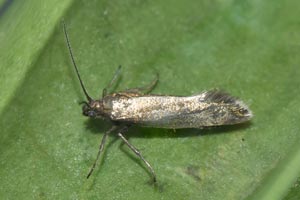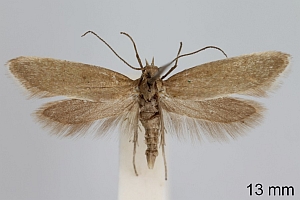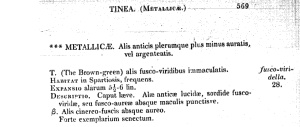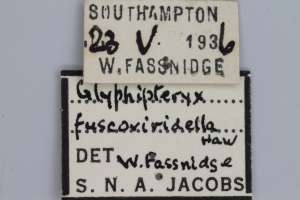1. Lebendfotos
1.1. Falter
2. Diagnose
Die Art ist zeichnungslos und graugrünlich [Rudolf Bryner].
2.1. Geschlecht nicht bestimmt
2.2. Erstbeschreibung
3. Biologie
3.1. Nahrung der Raupe
- [Juncaceae:] Luzula campestris (Feld-Hainsimse)
Nach der Zusammenstellung von Takács & Szabóky (2018) entwickelt sich die Raupe im Stängel der Feld-Hainsimse. Als Quellen nennt er Pelham-Clinton (1985) und Diakonoff (1986), also zusammenfassende Sekundärquellen. Pelham-Clinton (1985: 406) führt seine Angaben anscheinend einzig und allein auf den Aufsatz von Sich (1900) mit Titel "Note on the larva of Glyphipteryx fuscoviridella" zurück. Bei Sich (1900: 192) finden sich dann aber tatsächlich Angaben zu Freiland-Raupenfunden. Der Autor hatte am 4. Juni 1898 vier Falter beobachtet, die in einer mageren Wiese um Luzula campestris flogen. Er vermutete, dass das die Raupennahrungspflanze sein könnte und suchte am 14. April 1900 dann gezielt nach der Raupe: "I noticed that many of the Young leaves in the patches of Luzula campestris, in the same Meadow, were quite Brown. On digging up some of the plants I found the stems bearing brown leaves had been attacked by some internal feeding larva. One stem, with partially brown leaves, when split open, disclosed a stout whitish larva, resting head upwards in the interior. Around the roots of a neighbouring stem I found another similar larva, already surrounded by an open net-work cocoon. On April 18th I searched again and found a third larva, head downwards, in a stem of Luzula." In der Zucht dauerte die Puppenruhe dann genau 4 Wochen. Und Sich (1900) vermutet: "The end of March would be the best time to search for the larva." Ob jemals jemand diesem Rat gefolgt ist, weiß ich nicht.
4. Weitere Informationen
4.1. Andere Kombinationen
- Tinea fuscoviridella Haworth, 1828 [Originalkombination]
4.2. Synonyme
- Adela albicostella Duponchel, 1839
- Cephalispheira aereinitidella Millière, 1854
4.3. Faunistik
Nach SwissLepTeam (2010) liegen aus der Schweiz nur Literaturangaben aus dem Wallis vor.
(Autor: Erwin Rennwald)
4.4. Literatur
- Diakonoff, A.N. (1986): Glyphipterigidae auct. sensu latu (sensu Meyrick, 1913). - In: Amsel, H.G. et al. [Eds.]: Microlepidoptera Palaearctica, vol 7. 436 S., Karlsruhe (G. Braun). [Sekundärzitat]
- Erstbeschreibung: Haworth, A. H. (1828): Lepidoptera Britannica. Pars IV: 512-609. Londini (Richardus Taylor).
- Pelham-Clinton, E.C. (1985): Glyphipterigidae. — S. 400–407. In: Heath J, Emmet AM (Eds) The moths and butterflies of Great Britain and Ireland, 2. Colchester.
- Sich, A. (1900): Note on the larva of Glyphipteryx fuscoviridella. — Entomologist's Record and Journal of Variation, 12: 192-193.
- SwissLepTeam (2010). Die Schmetterlinge (Lepidoptera) der Schweiz: Eine kommentierte, systematisch-faunistische Liste. — Fauna Helvetica 25. Neuchâtel (CSCF & SEG).
- Takács, A. & C. Szabóky (2018): Discovery of the biology of Glyphipterix loricatella (Treitschke, 1833) (Lepidoptera, Glyphipterigidae), a borer in Iris (Iridaceae). — Nota Lepidopterologica, 41 (1): 181-187. [https://doi.org/10.3897/nl.41.24892] [zum open access-Artikel auf pensoft.net]




![Vorkommen in Großbritannien [Agassiz, Beavan & Heckford (2013): Checklist of the Lepidoptera of the British Isles]](/res/img/flag/gb.gif)
![Ausgestorben oder verschollen in Belgien [De Prins(2016): Catalogus van de Belgische Lepidoptera]](/res/img/flag/be.gif)
![Einzelnachweis in den Niederlanden [Muus & Corver (eds. 2021): Microlepidoptera.nl]](/res/img/flag/nl.gif)
![Vorkommen in Frankreich (europäisches Territorium ohne Korsika) [Vandromme et al. (2020): Liste systématique et taxinomique des Lépidoptères de France]](/res/img/flag/fr.gif)
![Vorkommen in Spanien (Festland) [Vives Moreno A. (2014)]](/res/img/flag/es.gif)
![Vorkommen in Portugal (Festland) [Corley (2015): Lepidoptera of Continental Portugal]](/res/img/flag/pt.gif)
![Vorkommen in Italien (Festland und kleine festlandsnahe Inseln) [Baraniak et al. (1995): Checklist delle Specie della Fauna Italiana 82]](/res/img/flag/it.gif)
![Vorkommen in Bulgarien [Rebel H. (1903): Lepidopterenfauna der Balkanländer - Bulgarien und Ostrumelien]](/res/img/flag/bg.gif)




